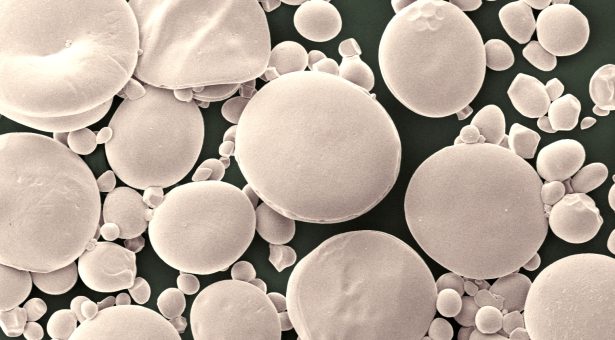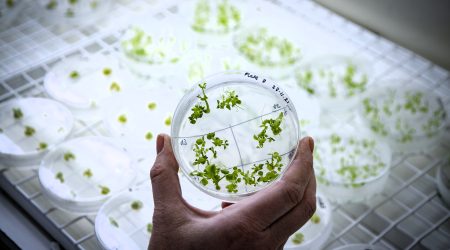Starch discovery reaps benefits for brewing, baking and milling industries

Research has brought clarity to the longstanding question of how starch granules form in the seeds of Triticeae crops – wheat, barley, and rye – unlocking diverse potential benefits for numerous industries and for human health.
Starch in wheat, maize, rice and potatoes is a vital energy-giving part of our diet and a key ingredient in many industrial applications from brewing and baking to the production of paper, glue, textiles, and construction materials.
Starch granules of different crops vary greatly in size and shape. Wheat starch (and those of other Triticeae) uniquely have two distinct types of granules: large A-type granules and smaller B-type granules.
The ratio of A- and B-type granules can affect the quality of wheat-based foods, such as bread and pasta. The two types of granules also present a problem for starch manufacturing industry because many of the smaller B-type granules are lost and therefore wasted during the milling process. Further, too many B-type starch granules in barley can cause a hazy or cloudy appearance in beer because they do not get digested and filtered out during the brewing process.
New research published in the Journal Plant Cell by the group of Dr David Seung at the John Innes Centre have made a breakthrough in solving this problem.
The team used genomic and experimental techniques to show that A- and B-type granules are formed by two distinct mechanisms.
By identifying an enzyme involved in B-type granule initiation and by then using conventional plant breeding techniques to remove this protein, they were able to produce wheat with low or no B-granules – with no penalties on plant development and without reducing the overall starch content.
Added to previous studies by this group which have shed light on the shape and formation of A-type granules, the discovery has major implications says first author of the study Dr Nitin Uttam Kamble:
“We discovered that the ubiquitous enzyme, (PHS1) is crucial for the formation of B-type granules in wheat. This is a scientific breakthrough because decades of research on this enzyme have failed to find a clear role for PHS1 in plants, and it shows that the A- and B-type granules of wheat form via different biochemical mechanisms. We can now use this knowledge to create variations in starch for different food and industrial applications.”
Dr David Seung, a group leader at the John Innes Centre added: “Industry does not generally like heterogeneity; it wants something nice and even to process smoothly and having these different types of starch granules in wheat has always represented a challenge.
“So, for us to discover the enzyme responsible for making the smaller granule population and to be able to use our breeding platform to reduce the number of B-type granules will hopefully be of great interest to many industry users.
“Combined together with our previous work, we now have a panel of diverse, novel wheat starches that vary in granule morphology, and these have diverse physical and chemical properties. We now invite businesses to work with us to investigate the potential benefits of these starches, such as in milling, pasta- and breadmaking.”
Starch is the main dietary carbohydrate in food eaten across the globe and consists of tiny semi-crystalline granules formed of simple sugar chains. In cereals starch granules form in the endosperm part of the seed.
As a raw material, starch is used in wallpaper, textiles, building materials, pharmaceuticals, glues, and thickeners.
Wheat and its relatives contribute more than one third of starch used for European industry purposes. Potato and maize starch have different composition and granule morphology to those in the Triticeae.
Over the years industry has gone to the expense of salvaging methods to solve the problem of mixtures of the large A-type and small B-type granules including using multiple filtrations to catch granules lost during processing. Removing the requirement for these processing steps will reduce costs and improve product performance.
Future lines of enquiry will be how size of granules affect starch digestibility, cooking quality,nutritional value and impact of dietary starches on human health.
Starch used in industry is often modified using physical and chemical methods to achieve the specific properties required for each end use. Having ways to modify starch in plants may avoid these costly and often environmentally unfriendly modification processes.
In addition to industrial benefits, the clarity about how starch granules are differentially initiated opens doors to greater understanding about the role that starch has in human diet and health.
The technology used in this research is available for evaluation and licensing through PBL.
Initiation of B-type starch granules in wheat endosperm requires the plastidial a-glucan phosphorylase PHS1 appears in Plant Cell
Image – “Wheat starch granules observed under the Scanning Electron Microscope. Large A-type and small B-type granules are visible. Image Credit: Brendan Fahy/Nitin Uttam Kamble”.



